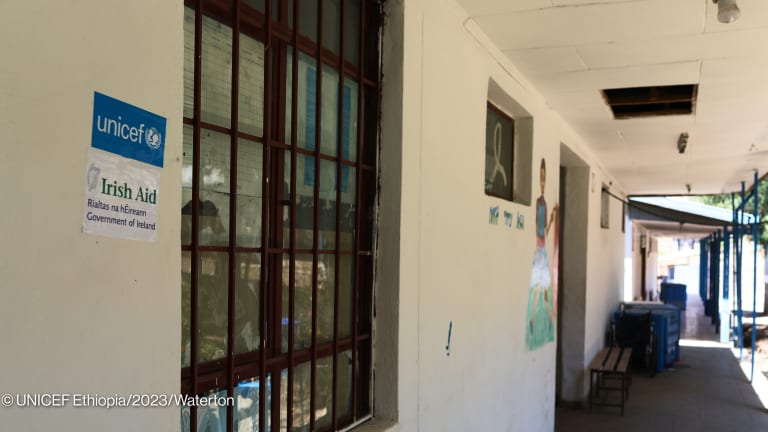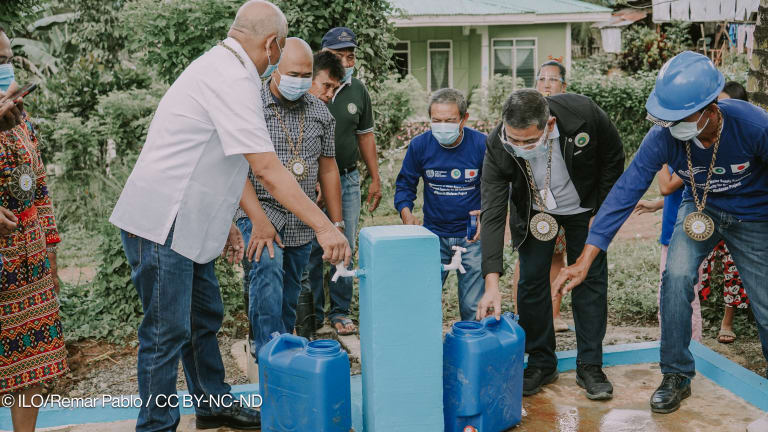6 things we learned from the 2023 ODA figures
Total official development assistance has reached a new level high with $223.7 billion. Devex explored the numbers to see how much the donors spend and where.
The Organisation for Economic Co-operation and Development last week released its preliminary report on 2023 official development assistance — or ODA — spending. It shows that total spending from members of the Development Assistance Committee totaled $223.7 billion, accounting for 0.37% of their combined gross national income, marking the fifth consecutive year that ODA has been at a record-high percentage, although it is still only around half the target of 0.7% ODA-to-GNI ratio target. DAC member spending rose by 1.8% in real terms compared to 2022. The rise can be attributed to the increase in ODA assistance to Ukraine, humanitarian aid, and overall contributions to multilateral organizations. Devex analyzed the key takeaways. 1. G7 countries continue to dominate The Group of Seven leading economies — Canada, France, Germany, Italy, Japan, the United Kingdom, and the United States — remain the dominant force when it comes to bilateral ODA. Combined, the G7 donors account for 76% of the total ODA with $170.9 billion, compared to $52.8 billion from the rest of the world. The United States is also increasingly dominant among the G7. In 2023, it spent $66 billion on ODA, almost double the contribution of Germany, which is in second place with $36.7 billion. Japan follows with $19.6 billion, the United Kingdom with $19.1 billion, and then France with $15.4 billion. However, the numbers show the U.S. still has the potential to provide even more aid. Its ODA-to-GNI ratio only sits at 0.24%, the lowest of all G7 countries. 2. The majority of donors gave less in 2023 ODA rose in 14 countries while it fell in 17 countries, and the story is one of Europe versus the rest of the world. Total ODA from DAC members that are part of the European Union fell by 7.7%. However European countries remain relatively generous compared to other donors. Their giving amounted to $92.9 billion, which represents 0.52% of their combined GNI. Total ODA from EU institutions, on the other hand, rose by 10% in real terms mostly due to the increase in support toward Ukraine through highly concessional macrofinancial assistance loans, which aims to provide short-term relief to the state budget. Among the notable declines are: • Estonia (-51.4%). • Poland (-36.6%). • Czech Republic (-34.3%). • Hungary (-31.3%). • Lithuania (-29.6%). The majority of these declines are attributable to the decrease in costs for in-donor refugees or an overall drop in their aid budget. 3. Only 5 donors hit the 0.7% target We’re still ways away from reaching the 0.7% ODA-to-GNI ratio. Despite the efforts of the G7 to increase their funding, Germany was the only one that was able to reach the goal. Out of the 31 DAC countries, only five were able to reach the ODA-to-GNI ratio of 0.7%: • Denmark (0.74%). • Germany (0.79%). • Sweden (0.91%). • Luxembourg (0.99%). • Norway (1.09%). 4. Ukraine continues to drive aid spending As Russia’s war in Ukraine reaches its third year, ODA to Ukraine increased even more, by 9% in real terms compared to 2022, amounting to $20 billion. Around $3.2 billion was in the form of humanitarian aid. The majority of the EU institutions’ spending — 54.4% of their total ODA — was directed toward Ukraine mainly in the form of concessional lending. The war in Gaza led to an increase in spending in the region. Estimated net ODA numbers show that $1.4 billion was spent — an increase of 12% compared to 2022. $758 million of the total was in the form of humanitarian aid. Bilateral ODA flows to Africa from DAC members amounted to $42 billion — an increase of 2%. Within this, net ODA to sub-Saharan Africa increased by 5%, amounting to $36 billion. ODA to the group of least developed countries stood at $37 billion — an increase of 3% in real terms compared to 2022. 5. Humanitarian and refugee spending remain at high levels Another driver of increasing spending was humanitarian aid. This increased by 4.8% and amounted to $25.9 billion — one of the highest levels ever recorded. Last year, the cost of looking after refugees spurred the increase in total ODA, as European countries took in millions of Ukrainians who were displaced. In 2023, ODA for in-donor refugee costs fell by 6.2%, but refugee spending still amounted to $31 billion — 13.8% of the total ODA from DAC member countries, and again, one of the highest levels ever recorded. 6. New Zealand and Norway spent a lot more Several donors exhibited a sharp increase in ODA spending in 2023. They include: • New Zealand (+41.3%). • Norway (+30.9%). • Iceland (+17.1%). • Japan (+15.7%). • United Kingdom (+12.1%). The reasons varied. New Zealand’s increase was brought about by an increase in its spending near the end of its budget cycle. Norway increased its bilateral aid in the form of humanitarian aid along with a rise in its support for Ukraine. Iceland increased its aid budget and spent more on in-donor refugee costs. Japan increased its bilateral aid and its multilateral contributions, while the United Kingdom provided additional resources to offset the costs of supporting refugees. Try out Devex Pro Funding today with a free five-day trial, and explore funding opportunities from over 850 sources in addition to our analysis and news content.
The Organisation for Economic Co-operation and Development last week released its preliminary report on 2023 official development assistance — or ODA — spending.
It shows that total spending from members of the Development Assistance Committee totaled $223.7 billion, accounting for 0.37% of their combined gross national income, marking the fifth consecutive year that ODA has been at a record-high percentage, although it is still only around half the target of 0.7% ODA-to-GNI ratio target. DAC member spending rose by 1.8% in real terms compared to 2022.
The rise can be attributed to the increase in ODA assistance to Ukraine, humanitarian aid, and overall contributions to multilateral organizations.
This story is forDevex Promembers
Unlock this story now with a 15-day free trial of Devex Pro.
With a Devex Pro subscription you'll get access to deeper analysis and exclusive insights from our reporters and analysts.
Start my free trialRequest a group subscription Printing articles to share with others is a breach of our terms and conditions and copyright policy. Please use the sharing options on the left side of the article. Devex Pro members may share up to 10 articles per month using the Pro share tool ( ).
Alecsondra Si is a Junior Development Analyst at Devex. She analyzes funding data from bilateral and multilateral agencies, foundations, and other public and private donors to produce content for Devex Pro and Pro Funding readers. She has a bachelor’s degree in International Studies - major in European Studies from De La Salle University, Manila, Philippines.








